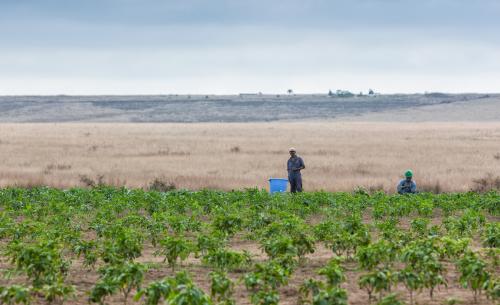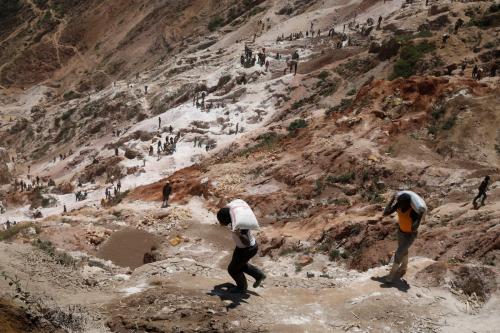Climate change requires concerted action at global, regional, and country levels. Global action is guided by the Paris Agreement, while country-level action is pursued under national climate strategies, adaptation plans, and the nationally determined contributions prepared by national governments and implemented with international support. Recently, country platforms for climate action, viz. Just Energy Transition Partnerships, have been developed to promote national and international cooperation for funding and managing just energy transitions in heavily coal-dependent developing countries.
At a regional level, the European Union has developed a “2030 climate & energy framework” and a “2050 long-term strategy” for EU-wide climate targets and policy. But for developing countries, a regional approach to climate change has so far been largely missing. Regional climate action—investments, policy reform, and capacity building—is essential since many sources and impacts of climate change are regional in nature and require a regional, or at least regionally coordinated, response. The Central Asia Regional Economic Cooperation Program (CAREC) is a potential model for regional climate action that could guide similar efforts in other developing regions of the world. CAREC’s membership includes eleven countries (Afghanistan, Azerbaijan, Georgia, Kazakhstan, Kyrgyz Republic, Mongolia, Pakistan, the People’s Republic of China, Tajikistan, Turkmenistan, and Uzbekistan), with the secretariat provided by the Asian Development Bank (ADB).1 On November 30, 2023, the CAREC Ministerial Conference approved the CAREC Climate Change Vision document, which sets the direction for regional cooperation on climate action among CAREC member countries through 2050.
In this blog we briefly review why regional action is needed on climate change, why CAREC represents a suitable platform for regional cooperation on climate change, and how the CAREC Climate Change Vision document lays out the directions for regional cooperation in addressing climate change with investment, capacity building, and knowledge work.
Climate action is needed at a regional level
Many aspects of climate change affect not just individual countries but regions, as documented for the CAREC region in a climate change scoping study recently published by the ADB. Regional cooperation is necessary to address the resulting challenges and opportunities.
- Weather and climate conditions are best monitored and predicted on a regional basis as recognized with regional programs under development by the Systematic Observations Financing Facility.
- Climate change greatly affects water resources which often need to be managed on a regional basis, since watersheds extend beyond borders, especially for smaller and mid-sized countries. Even for large countries, river basins can involve multiple neighboring countries (e.g., the Aral Sea Basin and the Ili-Irtysh River Basin in Central Asia). With increasing water scarcity in many regions, including greater Central Asia, regional cooperation on water management will become even more urgent than it is already.
- Agriculture policy must reflect the regional implications of the sector’s heavy and frequently inefficient use of water resources. Central Asian agriculture, which still is a significant source of regional GDP and exports, is a prime example of the urgency of this policy challenge.
- Energy resource management often requires cross-border cooperation, including and especially for renewable energy. Major hydro-electric investments can have significant regional implications (e.g. the Rhogun dam in Tajikistan), electricity grids are managed most efficiently on a regional basis supported by regional transmission capacity (e.g., the CASA-1000 project promising to supply Kyrgyz and Tajik hydro-electricity to Afghanistan and Pakistan), and backup capacity for intermittent wind and solar energy supplies is best managed on a regional basis.
- Green transport investments (e.g., electrification of railways) and regulation (e.g., vehicular emission standards) along international transport and transit corridors require regional cooperation, as does more efficient and hence energy saving border management. Investments in green transport infrastructure and efforts to reduce the cost and time required for border crossings among neighboring countries along the CAREC corridors are prime examples for such regional action.
- Climate-related natural disasters often have impacts across borders, whether due to flooding or droughts, and benefit from regionally coordinated preparedness and response. CAREC countries have a history of significant natural disaster events and have recognized the need for regional cooperation in this area.
- Many other areas of climate action can benefit from regional cooperation, including technology transfer for renewable energy; climate-smart agriculture; industrial and urban development; addressing climate-related health risks, especially in preparation for pandemics such as COVID; building regional research capacity and fostering regional knowledge exchange and networking; and coordinating macroeconomic and trade policies in response to challenges posed by climate change (for example, how best to respond to the European Union’s Carbon Border Adjustment Mechanism).
CAREC is a strong platform for regional cooperation in Greater Central Asia
CAREC has a longstanding track record as a unique platform for regional cooperation in the region, bringing together member countries and international partners. Founded in 2000 with the support of six multilateral financial institutions (ADB, European Bank for Reconstruction and Development, the International Monetary Fund, Islamic Development Bank, the United Nations Development Program, and the World Bank), CAREC focused during its first decade and a half of existence on supporting improved connectivity in transport, transit, trade, and energy. In 2017, member states approved the CAREC 2030 Strategy, which expanded CAREC’s mandate to include water, agriculture, tourism, health, and education, without an explicit focus on climate change. They subsequently invited the engagement of an expanded range of development partners, including the Asian Infrastructure Investment Bank, UN agencies, and bilateral official development partners. From 2001 through June 2023, investments with regional significance under the CAREC umbrella amounted to USD 47.3 billion (35% financed by ADB, 44% by other development partners, and 21% by CAREC governments). Investments so far have been heavily concentrated in transport and energy (70% and 20%, respectively), while research, technical assistance, and capacity building have been also promoted by the CAREC Secretariat and the affiliated CAREC Institute across their regional cooperation mandate.
The CAREC Climate Change Vision charts regional climate action
In recognition of the growing importance and urgency of the climate change agenda, CAREC ministers on November 30, 2023 approved the CAREC Climate Change Vision document and with it elevated climate change as a cross-cutting priority in the CAREC 2030 Strategy. After noting that the region has been and will be severely affected by climate change, the document posits a vision statement (“A Region of Sustainable Development, Shared Prosperity and Climate Resilience”) and lays out five priority areas for regional action: (i) develop a climate-smart agriculture system, (ii) support transition to a low-carbon energy system, (iii) reduce the carbon footprint in transport, (iv) promote green trade, and (v) strengthen disaster risk management.
To implement the Vision, ministers endorsed five specific initiatives:
- Establishment of a senior-level CAREC Climate Change Steering Committee, to be advised by a Cross-sectoral Working Group on Climate Change;
- Development of a medium-term CAREC Climate Change Action Plan to prioritize and phase in the investments and policy changes needed in the areas highlighted in the Vision document and integrate climate change considerations into all CAREC sectoral strategies;
- Coordination by the CAREC Secretariat and CAREC Institute of their respective analytical and capacity building activities to help CAREC member countries better assess regional climate and disaster risks and support risk-informed policies and investments;
- Organization of CAREC Development Partners Forums to further strengthen cooperation and coordination of international support for regional investments and policy action on climate change; and
- Development of a communication and outreach plan for the CAREC Climate Change Vision.
To assist with the implementation of the CAREC Climate Change Vision, ADB approved a technical assistance project that will provide technical and organizational support for the CAREC Climate Change Steering Committee’s work to be organized by the CAREC Secretariat.
With these important decisions taken, the elements for a concerted regional approach to climate action for the CAREC region are in place. The unique combination of a strong regional cooperation platform and a clear vision for climate action, underpinned by organizational and analytical support of a secretariat and of a regional think tank, and by the engagement of international development partners, will offer the opportunity for effective regional climate action. The experience of CAREC members can serve as an example for how countries in other regions could cooperate in tackling climate change.
-
Footnotes
- ADB has placed its regular assistance to Afghanistan on hold, effective 15 August 2021 (ADB Statement on Afghanistan published on 10 November 2021).







Commentary
A regional platform for climate action: The case of CAREC for the greater Central Asia region
November 30, 2023